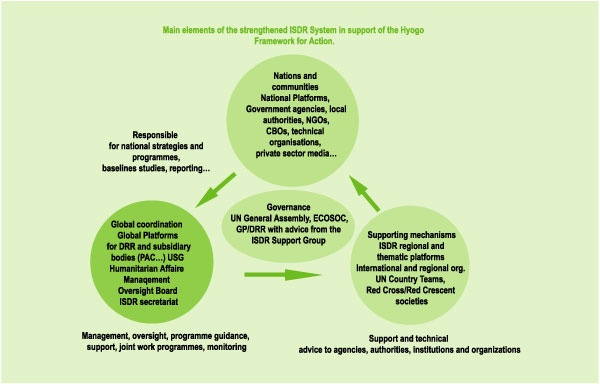| Towards a stronger ISDR System
Noting the overriding importance of effective action at national
and local levels for achieving risk reduction and sustainable development
globally, as well as the renewed political commitment from the 168
countries participating nations in the WCDR, the Under-Secretary–General
for Humanitarian Affairs, Jan Egeland, has proposed strengthened
International Strategy for Disaster Reduction, which will allow for
a more effective
ISDR network, as well as greater oversight and ownership of the strategy
by its members. In summary, the main elements of the proposed strengthened
ISDR system, as presented in the SG report to the UN General Assembly
on August 2005 (A/60/180) are:
- A global
forum called the Global Platform for Disaster Risk Reduction (GP/DRR)
with participation of Governments,
in addition to
UN agencies, regional organizations and civil society, with the
particular role of advising on, and committing to, the support and
implementation
of the Hyogo Framework, and to guide the various associated networks
and platforms; (this builds on the Inter-Agency Task Force on Disaster
Reduction, functioning 2000-2005). It also has a Programme Advisory
Committee (PAC), to ensure programmatic support and coherence.
An integrated work
programme for the ISDR system will be developed by PAC, and supported
by the ISDR secretariat;
- A Management
Oversight Board (MOB) with the function of providing advice on strategic,
managerial and resource mobilization
related issues
to the Under-Secretary-General for Humanitarian Affairs (Jan Egeland)
in his role as leader of the ISDR international system. A representative
from the UN Development Group serves as Vice-chair (Kathleen Cravero,
UNDP, has been appointed for this function);
- An
ISDR secretariat, as an independent entity within the United Nations
Secretariat, with a line of accountability to the Under-Secretary-General
for Humanitarian Affairs, to serve as an “honest broker”,
catalyst and main focal point within the UN system on disaster risk
reduction issues, to continue to promote ownership and commitment
to disaster risk
reduction with national, regional and international constituencies,
and to report on progress;
- National
platforms for disaster risk reduction defined by Governments in each
country, with designated responsibility
as national
forums for
coordination and follow-up for Hyogo Framework implementation,
and with appropriate links to the UN Country Teams, where applicable;
- Regional
networks or coordination platforms for disaster reduction cooperation
at regional and sub-regional levels,
including inter-agency
task forces and networks of national platforms, for coordination
and mainstreaming of disaster risk reduction in regional settings,
for
advocacy and information networking; and
- Thematic
platforms or networks of expertise, in support of priority areas
identified in
the Hyogo Framework, led or supported by the Global
Platform (Scientific panel/s to be developed).
The ISDR secretariat
remains an independent entity within the United Nations Secretariat,
accountable to the Under-Secretary-General
for Humanitarian Affairs, and serves as an “honest broker”,
catalyst and main focal point within the UN system on disaster risk reduction
issues, aiming to continue to promote ownership and commitment to disaster
risk reduction with national, regional and international constituencies,
and report on progress (more information available at www.unisdr.org/)
As part of the preparatory process for the first GP/DRR (scheduled for
mid 2007), preliminary regional discussions are being organized by the
ISDR secretariat in Africa, Asia, Pacific, Latin America and the Caribbean
and Europe. These informal and focused discussions will involve regional
inter-governmental organizations with support from relevant regional partners
and the regional representatives of the ISDR Reference Group. The meeting
for Latin America and the Caribbean was held in Panama on the 29-30 of
June, with participation of key UN agencies and regional and sub-regional
partners (see page 8).

| Preliminary Consultation Meeting
In January 2005, on ocassion of the World Conference on Disaster
Reduction, a plan of action was agreed upon for the next 10 years,
in which 168 governments committed themselves to advance disaster
risk reduction by identifying five main priorities for action. This
new plan is titled the Hyogo Framework for Action 2005-2015: Building
the resilience of nations and communities to disasters. The Framework
calls upon all States to take on the responsibility of implementing
this plan, and outlines specific activities and mechanisms for making
progress on the five priorities for action established.
Likewise, with the purpose of assisting countries in fulfilling
the commitments adopted in Kobe, the international community started
a process aimed at strengthening the International Strategy for Disaster
Reduction system, in order to have a more efficient mechanism for
disaster risk reduction at all levels. In this context, the UN/ISDR
is holding consultation meetings on all continents to make progress
on the creation of the forum: the titled Global Platform for Disaster
Risk Reduction with participation of governments, UN agencies, NGOs,
civil society, and other key players.
On June 29, 2006, in Panama
City, the UN/ISDR Regional Unit convened a preliminary consultation
meeting in order to make headway on this
process in Latin America and the Caribbean. The main goals of the
gathering were to convey information about the current progress on
the strengthened ISDR system, foster a regional commitment to the
process, and encourage contributions at the regional level. The meeting
also aimed at identifying regional disaster reduction priorities
for the Joint Work Plan of the ISDR system, discussing the most appropriate
format to capture these priorities and, along with governments, developing
a regional preparatory process for the first session of the Global
Platform for Disaster Risk Reduction.
|
|




